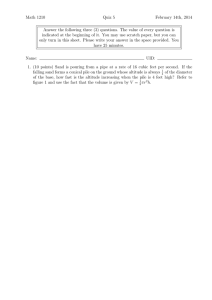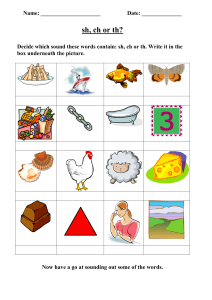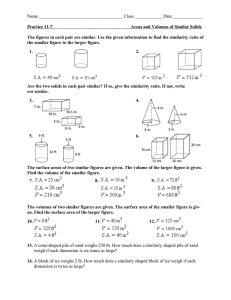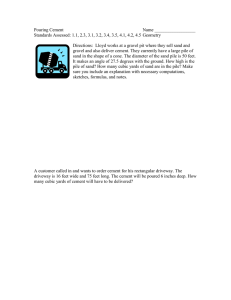Solved Exercises Geotechnics Exam March 2014
advertisement
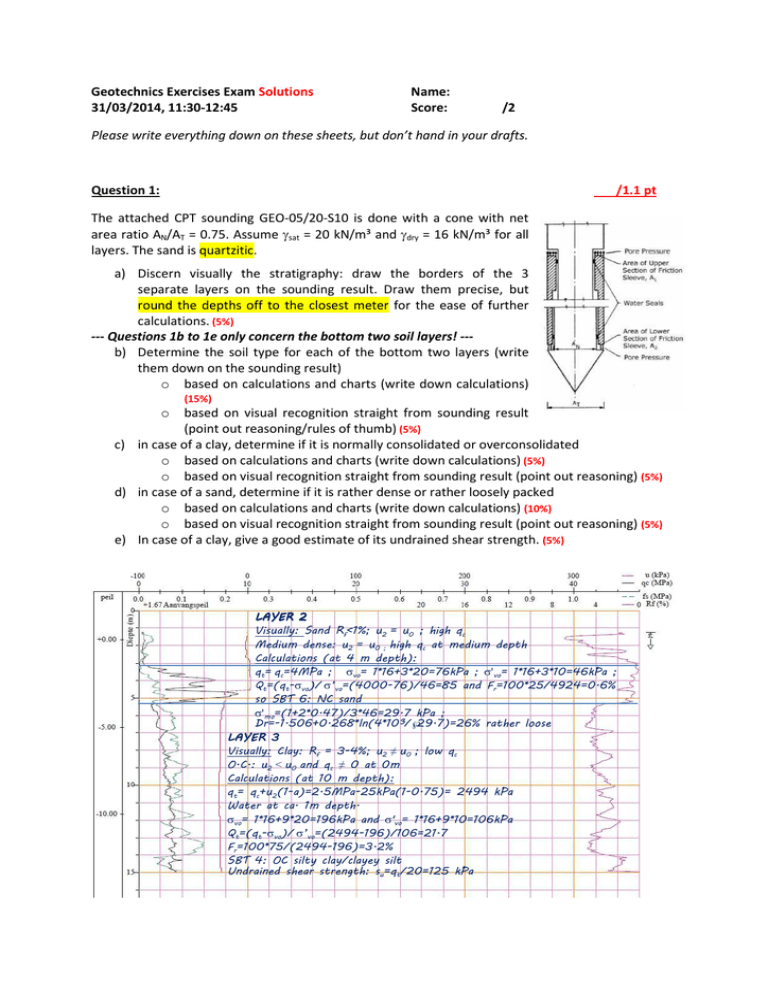
Geotechnics Exercises Exam Solutions 31/03/2014, 11:30-12:45 Name: Score: /2 Please write everything down on these sheets, but don’t hand in your drafts. Question 1: /1.1 pt The attached CPT sounding GEO-05/20-S10 is done with a cone with net area ratio AN/AT = 0.75. Assume γsat = 20 kN/m³ and γdry = 16 kN/m³ for all layers. The sand is quartzitic. a) Discern visually the stratigraphy: draw the borders of the 3 separate layers on the sounding result. Draw them precise, but round the depths off to the closest meter for the ease of further calculations. (5%) --- Questions 1b to 1e only concern the bottom two soil layers! --b) Determine the soil type for each of the bottom two layers (write them down on the sounding result) o based on calculations and charts (write down calculations) (15%) based on visual recognition straight from sounding result (point out reasoning/rules of thumb) (5%) c) in case of a clay, determine if it is normally consolidated or overconsolidated o based on calculations and charts (write down calculations) (5%) o based on visual recognition straight from sounding result (point out reasoning) (5%) d) in case of a sand, determine if it is rather dense or rather loosely packed o based on calculations and charts (write down calculations) (10%) o based on visual recognition straight from sounding result (point out reasoning) (5%) e) In case of a clay, give a good estimate of its undrained shear strength. (5%) o LAYER 2 Visually: Sand Rf<1%; u2 = u0 ; high qc Medium dense: u2 = u0 ; high qc at medium depth Calculations (at 4 m depth): qt= qc=4MPa ; σvo= 1*16+3*20=76kPa ; σ'vo= 1*16+3*10=46kPa ; Qt=(qt-σvo)/ σ’vo=(4000-76)/46=85 and Fr=100*25/4924=0.6% so SBT 6: NC sand σ'mo=(1+2*0.47)/3*46=29.7 kPa ; Dr=-1.506+0.268*ln(4*10³/√29.7)=26% rather loose LAYER 3 Visually: Clay: Rf = 3-4%; u2 ≠ u0 ; low qc O.C.: u2 < u0 and qc ≠ 0 at 0m Calculations (at 10 m depth): qt= qc+u2(1-a)=2.5MPa-25kPa(1-0.75)= 2494 kPa Water at ca. 1m depth. σvo= 1*16+9*20=196kPa and σ'vo= 1*16+9*10=106kPa Qt=(qt-σvo)/ σ’vo=(2494-196)/106=21.7 Fr=100*75/(2494-196)=3.2% SBT 4: OC silty clay/clayey silt Undrained shear strength: su=qt/20=125 kPa Question 2: /0.9 pt A CPT sounding result is given, showing a clay layer and a sand layer. The water level is at 0 m. A single precast concrete pile, dimensions 250 mm * 300 mm is to be driven in the soil; the pile is straight from head to toe. After installation, a uniform load of 50 kPa is imparted on the soil; this loading causes the clay layer to settle linearly with depth, with a total of 15 mm. For all soils here K0 tanδ=0.25 and γsat = 20 kN/m³ and γdry = 16 kN/m³. When the pile is loaded, and if the pile is founded in the sand layer, it will not settle nor will it deform. a) Choose the depth to which the pile should be driven to get a maximum pile load capacity when calculated with the Koppejan method. Show this depth on the sounding, together with the calculations. (10%) b) Determine the pile load capacity of this pile (no safety factors to be applied). (25%) c) When the displacement pile is driven, the sand is densified and the cone resistance increases with 5%. This should not be taken into account for the load capacity calculations, but when designing the driving rig this higher resistance needs to be incorporated. What is the minimum force required to drive the pile to its depth (assuming zero viscous friction losses)? (10%) a) The ideal depth: γsat = 20 kN/m³ p= 50 kPa a= 300 mm b= O= 250 mm 1,1 m Deq = 4Deq = 309 mm 1,24 m 8Deq = 2,47 m Δzclay= 5m Therefore, ideal depth is: F.L.+4D < 9 F.L.-8D > 5,3 F.L.= 7,77 m 7,76 < F.L. < 7,77 Say F.L.= Then: 7,77 m qc,clay = 1 MPa qc,sand = 15 MPa b) Load Resistance: Qb,max = qb;max * Ap b/a = 1,20 s ≈ 0,95 qb;max = α p * β * s * qc,Koppejan qb;max = Qb,max = 14,25 MPa 1068,8 kN Settling of clay (mm) ∆Hclay = For 0 < z < 5 m: negative skin friction. Fs = A σ’h tanδ = O hclay K0 σ’v tanδ Fs = O hclay K0 tanδ (p+p+hclay* γ)/2 Fns = 103,13 kN For z > 5 m: positive skin friction Qs,max = α s * Os *Σ i (Li * qc,i) qs;max = α s * qc qs;max = Qs,max = 150 kPa 410,5 kN Total allowable pile resistance Rca = Qb,max + Qs,max - Fns Rca = 1376 kN c) Driving after densification 5 % increase qc,sand,new = 15,75 MPa qc,clay,new = 1,05 MPa Qb,max,new = 1122,2 kN Qs,max,new = 486,1 kN entirely positive skin friction now! Qtot,new = 1608,2 kN β= 1 αp = 1 α s = 0,01 15 mm
